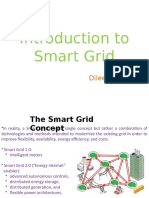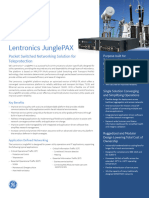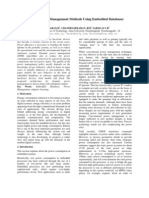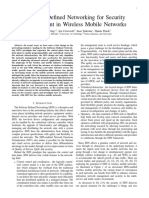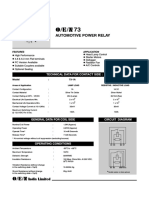39
39
Uploaded by
JQL contactCopyright:
Available Formats
39
39
Uploaded by
JQL contactCopyright
Available Formats
Share this document
Did you find this document useful?
Is this content inappropriate?
Copyright:
Available Formats
39
39
Uploaded by
JQL contactCopyright:
Available Formats
WHITE PAPER
Intel® Data Center Manager
Lenovo® Smart Grid Technology
Driving Up Data Center Energy Efficiency with
Scalable Server-Level Power Management and Control
Lenovo® Smart Grid Technology leverages Intel® Data Center Manager and Node Manager
to achieve world-class server power efficiency.
Lenovo is helping data center managers maximize power efficiency at the server
and device level while also scaling energy management to the rack and data center
levels. Leveraging Intel® Data Center Manager and Node Manager, Lenovo® Smart Grid
Technology can manage up to 1,000 nodes and provides policy-based control to
significantly lower energy consumption.
The dynamic approach to managing and adjusting power takes advantage of Intel® Xeon®
processor micro-architecture. Lenovo Smart Grid combines information technology and
energy technology to deliver a centralized, remote management solution that helps
control operating costs without impacting data center performance.
Intelligent Power Policy The solution scales to address large data
Recommendation centers, and also allows flexible analysis
The first step towards data center and control of power management by
energy efficiency involves monitoring rack, row, or groups.
and analyzing the real-time power
consumption patterns. The Lenovo Smart Performance-Aware Dynamic
Grid console gives a detailed view of Power Control
power usage for ThinkServers and other After observing power consumption and
data center devices that support Intel adjusting power policies, data center
Data Center Manager and Node Manager managers can use Lenovo Smart Grid
technology. The agentless solution to introduce additional controls. Power
implements closed-loop full-process capping capabilities allow the definition
management including the ability to: of an upper limit for power consumption,
which can be configured for specific
• Discover and import a data center device
servers or groups of servers.
• Monitor the device’s power consumption
Lenovo Smart Grid power consumption
• Learn how power consumption varies
trend data greatly assists data center
over time
managers in terms of setting the upper
• Implement power-saving policies power limits, and avoids reliance on
• Analyze the results of the power-saving vendor-provided, worst-case power
policies consumption specifications. Instead,
• Recommend power policy adjustments power caps can be based on actual
observed power consumption behaviors
On a device-by-device basis, Smart Grid for specific system configurations,
uses the collected power consumption workloads, and time of day.
data to evolve the most appropriate
power management policy and lower the
device’s consumption.
Driving Up Data Center Energy Efficiency with Scalable Server-Level Power Management and Control
Although server performance is tied to Browser-Based, Non-Invasive • Increase uptime by avoiding power spikes
power consumption levels, power caps can Solution that can lead to equipment outages
be implemented with minimal impact on The server/browser architecture makes • Improve server rack densities by
server performance. Tests1 have shown Lenovo Smart Grid easy to deploy and adjusting power and workloads
that reducing power by almost 20% has use. No agents are required on the
no noticeable impact on performance. monitored servers, and once installed on a • Introduce energy charge-backs based on
For more aggressive capping, Lenovo server, results are accessible using a web actual consumption by workloads
Smart Grid monitors server performance browser. • Educate users and promote more “green”
indicators every five minutes; alerts
Power consumption data can be viewed IT services
are generated if performance exceeds
a defined threshold and caps can be for specific periods of time, and the • Shift workloads across multiple data
adjusted accordingly based on power intuitive views make it easy to extract centers around the world, taking
policies and service level requirements. information about average and peak advantage of lower energy costs (off-
usage. Data center results can also be peak rates) in other time zones
Power capping and subsequent power broken down by server, rack, row, or room.
monitoring provide tools for data
About Lenovo Smart Grid
center managers that want to evaluate Conclusions
and optimize performance-per-watt Lenovo Smart Grid Technologies
With today’s high energy costs, the compliment the world-class energy
results throughout the data center.
average 400W server takes $800 or more efficiency of the company’s ThinkServer
Server configurations can be studied to
out of the annual data center operating systems. New rack designs, ENERGY STAR
determine the power level that delivers
budget. IT and facilities management certifications, 80+ Gold-rated power
the best energy value. While data center
teams are under extreme pressure to choices, and Smart Grid make the latest
managers may not want to utilize power
cut these costs by driving up server ThinkServers up to 45% more efficient
capping in this manner during times of
efficiency. Lenovo Smart Grid’s power than previous generation servers.
peak workloads, it can be highly effective
monitoring and control capabilities offer
for cost controls during night hours or for
visibility into dynamic power consumption About Intel Data Center Manager
large compute-intensive applications that
behaviors in the data center, and closed-
can be slowed slightly without impacting Intel® Data Center Manager (Intel® DCM)
loop feedback that allows accurately
the user experience. provides accurate, real time power and
tailoring power policies for optimal
thermal monitoring and management for
During times of power outages, when energy use.
individual servers, group of servers, racks
workloads shift to disaster recovery and IT equipment such as PDUs in the data
Besides optimizing energy efficiency
sites with fewer server resources, power center. It’s a capability that is useful for
and lowering energy costs, data center
capping can be used to accommodate both IT and facility administrators, which
managers are using energy management
more mission-critical applications or allows them to work jointly to reduce their
solutions like Lenovo Smart Grid, based on
to prioritize power allocations. Power energy footprint.
Intel Data Center Manager and Node
capping to drive up performance-per-watt
Manager, to:
will also extend the life of UPS units
during outages.
1
“Preserving Performance While Saving Power Using Intel® Intelligent Power Node Manager and Intel® Data Center Manager,”
Intel white paper, http://software.intel.com/sites/datacentermanager/node_manager_white_paper_bmw.pdf
For more information on Intel® Data Center Manager, visit www.datacentermanager.intel.com
For more information on Lenovo® Smart Grid Technology, visit
support.lenovo.com/en_SE/downloads/detail.page?DocID=DS029844
Intel ® Node Manager technology requires a computer system with an Intel ® Xeon ® processor, supported Intel ® Enterprise chipset, BIOS, and other requirements documented in the applicable Platform Design Guideline
documentation and applications enabled for virtualization technology. Functionality, performance or other power capping technology benefits will vary depending on hardware and software configurations.
Performance tests and ratings contained within this document are measured using specific computer systems and/or components and reflect the approximate performance
of Intel products as measured by those tests. Any difference in system hardware or software design or configuration may affect actual performance. Buyers should consult
other sources of information to evaluate the performance of systems or components they are considering purchasing. For more information on performance tests and on the
performance of Intel products, visit Intel Performance Benchmark Limitations. Intel does not control or audit the design or implementation of third party benchmarks or Web
sites referenced in this document. Intel encourages all of its customers to visit the referenced Web sites or others where similar performance benchmarks are reported and
confirm whether the referenced benchmarks are accurate and reflect performance of systems available for purchase.
This paper is for informational purposes only. THIS DOCUMENT IS PROVIDED “AS IS” WITH NO WARRANTIES WHATSOEVER, INCLUDING ANY WARRANTY OF
MERCHANTABILITY, NONINFRINGEMENT, FITNESS FOR ANY PARTICULAR PURPOSE, OR ANY WARRANTY OTHERWISE ARISING OUT OF ANY PROPOSAL,
SPECIFICATION, OR SAMPLE. Intel disclaims all liability, including liability for infringement of any proprietary rights, relating to use of information in this specification.
No license, express or implied, by estoppel or otherwise, to any intellectual property rights is granted herein. Intel may make changes to specifications and product
descriptions at any time, without notice.
Intel, the Intel logo, Xeon, and Xeon Inside are trademarks of Intel Corporation in the U.S. and other countries.
*Other names and brands may be claimed as the property of others.
Copyright © 2012 Intel Corporation. All rights reserved.
You might also like
- DBS Case Study - SolutionDocument4 pagesDBS Case Study - SolutionMilan mathew100% (2)
- PowerOn Fusion PDFDocument16 pagesPowerOn Fusion PDFJagan VanamaNo ratings yet
- Siemens Powermanager Brochure PDFDocument10 pagesSiemens Powermanager Brochure PDFMinh TuNo ratings yet
- Grid Automation Solutions Brochure Br910006enDocument7 pagesGrid Automation Solutions Brochure Br910006enChintanPandyaNo ratings yet
- ABT Energy Management SystemDocument4 pagesABT Energy Management SystemAlok GhildiyalNo ratings yet
- PM6 Range: Medium Voltage Distribution Disconnector Switch Up To 52 KVDocument56 pagesPM6 Range: Medium Voltage Distribution Disconnector Switch Up To 52 KVgogoNo ratings yet
- Generator ControlDocument4 pagesGenerator ControlSergioNo ratings yet
- Sentron Data Sheet 050310Document8 pagesSentron Data Sheet 050310Kevin GurungNo ratings yet
- Spectrum Power™ Distribution Network Applications (DNA) : Answers For EnergyDocument2 pagesSpectrum Power™ Distribution Network Applications (DNA) : Answers For EnergykotiniNo ratings yet
- CIRED2011 0716 FinalDocument4 pagesCIRED2011 0716 FinalkotiniNo ratings yet
- ABB 1053 WPO GainingControlElectricalDataCenterDocument2 pagesABB 1053 WPO GainingControlElectricalDataCenterYashveer TakooryNo ratings yet
- Thermal Management in Data Center SDocument31 pagesThermal Management in Data Center SNabin BaskotaNo ratings yet
- Electrical Engineering Services For Data CentersDocument2 pagesElectrical Engineering Services For Data CentersSimon IacobucciNo ratings yet
- Eaton Intelligentpowermanager Editions Br152046en en GBDocument8 pagesEaton Intelligentpowermanager Editions Br152046en en GBhecamp.coNo ratings yet
- EcoStruxure Microgrid Advisor HandoutDocument2 pagesEcoStruxure Microgrid Advisor HandoutThabangNo ratings yet
- ABB_MNS_Digital_MCC_9AKK107680A7379_ENcDocument2 pagesABB_MNS_Digital_MCC_9AKK107680A7379_ENckasban.veicoNo ratings yet
- Chapter FiveDocument13 pagesChapter FiveeyerusdbNo ratings yet
- Introduction To Smart GridDocument26 pagesIntroduction To Smart GridDileep GNo ratings yet
- GE Advanced SoftwareDocument11 pagesGE Advanced SoftwareDejanNo ratings yet
- Lentronics Junglepax Brochure 31950a en LTR 202001 r006Document8 pagesLentronics Junglepax Brochure 31950a en LTR 202001 r006hayashiedNo ratings yet
- E Mesh Monitor BrochureDocument4 pagesE Mesh Monitor Brochuredave chaudhuryNo ratings yet
- Dynamic Power Management Methods Using Embedded Databases: Prabakaran.R, Chandrasekaran .RM, Sarma D.V.RDocument4 pagesDynamic Power Management Methods Using Embedded Databases: Prabakaran.R, Chandrasekaran .RM, Sarma D.V.RdvrsarmaNo ratings yet
- Echelon Smart Server InfoDocument4 pagesEchelon Smart Server InfoAlexis ZapataNo ratings yet
- Site Infrastructure ManagementDocument4 pagesSite Infrastructure ManagementAbdallaNo ratings yet
- key-to-5-critical-data-centerDocument6 pageskey-to-5-critical-data-centerAlberto JohnNo ratings yet
- AcuCloud - Use Case and FunctionsDocument15 pagesAcuCloud - Use Case and FunctionsInformatica AxiomeNo ratings yet
- Catalogo ENglish PreDocument32 pagesCatalogo ENglish PrestevestievanuNo ratings yet
- Envision For Bactalk: Features and HighlightsDocument2 pagesEnvision For Bactalk: Features and HighlightsAllan AnthonNo ratings yet
- NES EAP LVGM+EB Brochure - August 2017Document2 pagesNES EAP LVGM+EB Brochure - August 2017Dariusz KurowskiNo ratings yet
- C163 Imvision AIM Brochure 108798 Nov 18Document18 pagesC163 Imvision AIM Brochure 108798 Nov 18Diego Gomez CaroNo ratings yet
- PowerShield 8 Solution Overview - 3.0 - 19Document4 pagesPowerShield 8 Solution Overview - 3.0 - 19Sudharsan KingNo ratings yet
- 998-1263071 Gma-Gb A PDFDocument2 pages998-1263071 Gma-Gb A PDFMohamed MOUCHRIFNo ratings yet
- Unit 2-Chap 1 - Modern NetworkingDocument18 pagesUnit 2-Chap 1 - Modern NetworkingTim CookNo ratings yet
- Data Centre Monitoring and Management: e BookDocument14 pagesData Centre Monitoring and Management: e BookAnonymous GI3MMOCftCNo ratings yet
- White Paper Communications For The Smart GridDocument10 pagesWhite Paper Communications For The Smart GridTetianaNo ratings yet
- SCADA For E-Mobility: Operational ConfidenceDocument8 pagesSCADA For E-Mobility: Operational ConfidencePaolo SalinettiNo ratings yet
- Net Terrain Environment MonitorDocument4 pagesNet Terrain Environment MonitorIqbal Mohd SarimNo ratings yet
- EN WPE0048 Switch-DifferencesDocument13 pagesEN WPE0048 Switch-DifferencesCarlos ChávezNo ratings yet
- 998-21974704 GMA Power For Data Centers EGuideDocument24 pages998-21974704 GMA Power For Data Centers EGuidepapa abdoul sowNo ratings yet
- Solar Future UETDocument42 pagesSolar Future UETAsim RiazNo ratings yet
- RE500 755796 LRENbDocument8 pagesRE500 755796 LRENbSUBAS CHANDRA BEHERANo ratings yet
- Gridstack - Tech Spec - 006 - 01 - ENDocument2 pagesGridstack - Tech Spec - 006 - 01 - ENAravind ShankarNo ratings yet
- Ds FJ Ism enDocument7 pagesDs FJ Ism enHamid Reza MoradiNo ratings yet
- NMX SCADA Rail Brochure - 9AKK107046A4468-US-webDocument8 pagesNMX SCADA Rail Brochure - 9AKK107046A4468-US-webCamilo LunaNo ratings yet
- Power Management Techniques For Wireless Sensor Networks: A ReviewDocument5 pagesPower Management Techniques For Wireless Sensor Networks: A ReviewLakshmi KNo ratings yet
- NM SCADA For Rail Brochure - 9AKK107046A4468-US-webDocument8 pagesNM SCADA For Rail Brochure - 9AKK107046A4468-US-webJulio SaavedraNo ratings yet
- 2017 - SOLO POR CBENCH - Performance Analysis of Software Defined Network Controller Architecture-A Simulation Based SurveyDocument7 pages2017 - SOLO POR CBENCH - Performance Analysis of Software Defined Network Controller Architecture-A Simulation Based SurveyBell BonNo ratings yet
- IoT - Questions - With AnswersDocument4 pagesIoT - Questions - With AnswersDebashish MukherjeeNo ratings yet
- IoT Box 60533323Document12 pagesIoT Box 60533323Yamen BousselmiNo ratings yet
- carbonTRACK - Solution Offering - 2022 KENYADocument16 pagescarbonTRACK - Solution Offering - 2022 KENYAClaris muthoniNo ratings yet
- NetSight DSDocument7 pagesNetSight DSjosemiguel1992No ratings yet
- Pre Print Comnet2014Document7 pagesPre Print Comnet2014Boopathy PandiNo ratings yet
- Datagrid Company Profile 2014 Ver.6 PDFDocument20 pagesDatagrid Company Profile 2014 Ver.6 PDFHadi Aja Panggil GueNo ratings yet
- Choi et.al (2015) The method to secure scalability and high density cloud DCDocument5 pagesChoi et.al (2015) The method to secure scalability and high density cloud DCw.lin.gs.1888No ratings yet
- NRJED111211EN - CA Panel Builder Cat 2019Document44 pagesNRJED111211EN - CA Panel Builder Cat 2019solimanNo ratings yet
- Feeder Reconfiguration Techniques:A Review: Ramsha Sajjad Abbasi Tahir MehmoodDocument5 pagesFeeder Reconfiguration Techniques:A Review: Ramsha Sajjad Abbasi Tahir MehmoodabbasaliNo ratings yet
- Energy Cost ControlDocument4 pagesEnergy Cost ControlSergioNo ratings yet
- Integrated SCADA Solutions To Optimize Utility PV Plant PerformanceDocument5 pagesIntegrated SCADA Solutions To Optimize Utility PV Plant PerformanceJorge Landim CarvalhoNo ratings yet
- ABB RMU Digital Upgrade Webinar PDFDocument37 pagesABB RMU Digital Upgrade Webinar PDFadekunle olopadeNo ratings yet
- Software Defined Networking (SDN) - a definitive guideFrom EverandSoftware Defined Networking (SDN) - a definitive guideRating: 2 out of 5 stars2/5 (2)
- geothermal-energy-da23eb49Document7 pagesgeothermal-energy-da23eb49JQL contactNo ratings yet
- 21Document68 pages21JQL contactNo ratings yet
- SBD-PMA-14Document131 pagesSBD-PMA-14JQL contactNo ratings yet
- 10Document22 pages10JQL contactNo ratings yet
- 9Document8 pages9JQL contactNo ratings yet
- 53333Document105 pages53333JQL contactNo ratings yet
- Model-95G-Gravity-Feed-Spray-GunDocument8 pagesModel-95G-Gravity-Feed-Spray-GunJQL contactNo ratings yet
- 23Document12 pages23JQL contactNo ratings yet
- 24Document14 pages24JQL contactNo ratings yet
- 45Document6 pages45JQL contactNo ratings yet
- 35Document2 pages35JQL contactNo ratings yet
- 38Document1 page38JQL contactNo ratings yet
- 15Document5 pages15JQL contactNo ratings yet
- 36Document24 pages36JQL contactNo ratings yet
- 24Document3 pages24JQL contactNo ratings yet
- 5 kpmg-whitepaper-connected-machinesDocument12 pages5 kpmg-whitepaper-connected-machinesJQL contactNo ratings yet
- 6 white-paper-internet-of-things-8614Document5 pages6 white-paper-internet-of-things-8614JQL contactNo ratings yet
- 2wp-iot-analytics-iot-integration-enDocument6 pages2wp-iot-analytics-iot-integration-enJQL contactNo ratings yet
- 5LEGIC_IIoT_WhitepaperDocument6 pages5LEGIC_IIoT_WhitepaperJQL contactNo ratings yet
- 3wp_airenergyefficiency_en_final_4_2Document8 pages3wp_airenergyefficiency_en_final_4_2JQL contactNo ratings yet
- 3WP-IoT-in-Manufacturing-PDFDocument8 pages3WP-IoT-in-Manufacturing-PDFJQL contactNo ratings yet
- 4 securing future for iiotDocument8 pages4 securing future for iiotJQL contactNo ratings yet
- 3 Semi IoT TechNoteDocument5 pages3 Semi IoT TechNoteJQL contactNo ratings yet
- 2 iot-whitepaper-and-tutorialDocument26 pages2 iot-whitepaper-and-tutorialJQL contactNo ratings yet
- 4 Iot securityDocument32 pages4 Iot securityJQL contactNo ratings yet
- 5 forum-IoT-Whitepaper-draft-v1.0Document27 pages5 forum-IoT-Whitepaper-draft-v1.0JQL contactNo ratings yet
- 13 industrial-remote-monitoringDocument7 pages13 industrial-remote-monitoringJQL contactNo ratings yet
- Canadian Entrepreneurship and Small Business Management Canadian 10th Edition Balderson Test BankDocument5 pagesCanadian Entrepreneurship and Small Business Management Canadian 10th Edition Balderson Test Bankelijahlonga9w9i100% (42)
- Electro Chemical MachiningDocument10 pagesElectro Chemical Machiningdev2945No ratings yet
- Design Reliability and MaintenabilityDocument4 pagesDesign Reliability and MaintenabilitymichealNo ratings yet
- Herrypramono,+##Default - Groups.name - ProductionEditor##,+Layout 2+Artikel+2+JMan+Vol+19+No.+1+ (CC)Document21 pagesHerrypramono,+##Default - Groups.name - ProductionEditor##,+Layout 2+Artikel+2+JMan+Vol+19+No.+1+ (CC)Rasda MuhammadNo ratings yet
- FBI File Waco Part 01 of 10 TextDocument78 pagesFBI File Waco Part 01 of 10 TextBumker BrossNo ratings yet
- Introduction To Personality: Submitted By-Shweta Uppal Saloni Sahu Sanjit MohapatraDocument31 pagesIntroduction To Personality: Submitted By-Shweta Uppal Saloni Sahu Sanjit Mohapatraanshu bhatia57% (7)
- Summer Internship Project HDFC Bankpdf PDFDocument108 pagesSummer Internship Project HDFC Bankpdf PDFAkNo ratings yet
- Business FinanceDocument90 pagesBusiness FinanceSandara beldo100% (1)
- Craft Master Interior CatalogDocument24 pagesCraft Master Interior CatalogDebashish Goswami0% (1)
- Technical English 2020 Ch3Document6 pagesTechnical English 2020 Ch3Ahmed F. AlHallaqNo ratings yet
- Latihan Soal Bab 1, 2, Dan 3Document4 pagesLatihan Soal Bab 1, 2, Dan 3welly kristiantoNo ratings yet
- Lectures Notes Microeconomy Theory - Guoqiang TianDocument457 pagesLectures Notes Microeconomy Theory - Guoqiang TianPedro Desiderio100% (1)
- FWcs6 ContentsDocument12 pagesFWcs6 Contentscddfx786No ratings yet
- Automotive Power Relay: Technical Data For Contact SideDocument3 pagesAutomotive Power Relay: Technical Data For Contact SideJesus HernadezNo ratings yet
- Automatic Reverse Braking System: Ketan Meshram, Manish Pawar, Rohan Murkute, Jayesh MahajanDocument3 pagesAutomatic Reverse Braking System: Ketan Meshram, Manish Pawar, Rohan Murkute, Jayesh Mahajanjayesh mahajanNo ratings yet
- Amended Complaint in Nancy Worley LawsuitDocument12 pagesAmended Complaint in Nancy Worley LawsuitMike CasonNo ratings yet
- A TO Z of TILESDocument10 pagesA TO Z of TILESuffshezy4No ratings yet
- Glosar Facebook RoenroDocument136 pagesGlosar Facebook RoenroLeonNo ratings yet
- Excel Shortcuts BibleDocument20 pagesExcel Shortcuts Bibletiki_tiki_xiiiNo ratings yet
- Scmpe Compiler 4.0 - Ca Final - by Ca Ravi AgarwalDocument824 pagesScmpe Compiler 4.0 - Ca Final - by Ca Ravi Agarwalaella shivaniNo ratings yet
- Flexi MR Bts and Airscale Bts HW Roadmap q3 2018 PDF Free 29 56Document28 pagesFlexi MR Bts and Airscale Bts HW Roadmap q3 2018 PDF Free 29 56TestNo ratings yet
- Nov 2023 - Paper 1 - V1Document16 pagesNov 2023 - Paper 1 - V1zavierrrofficialNo ratings yet
- 2014 Rapala CanadaDocument136 pages2014 Rapala Canadagbqfnq2p8bNo ratings yet
- Importance of Human Resource Management in An Organization: By: Amulya PDocument7 pagesImportance of Human Resource Management in An Organization: By: Amulya PVarshini NagarajuNo ratings yet
- Handbook of Troubleshooting Plastics Processes A Practical GuideDocument55 pagesHandbook of Troubleshooting Plastics Processes A Practical GuideGabriel Cahueque CoelloNo ratings yet
- May 2023 Current Affairs Magazine For Upsc CseDocument184 pagesMay 2023 Current Affairs Magazine For Upsc CseFrancescoBuccaNo ratings yet
- UHF RFID Reader Serial Interface - V3.7Document51 pagesUHF RFID Reader Serial Interface - V3.7Rap FigueroaNo ratings yet
- Yarn Offer SheetDocument2 pagesYarn Offer SheetN.M. EESWARANNo ratings yet
- M Tech 1sem BDA Question Paper With AnswersDocument98 pagesM Tech 1sem BDA Question Paper With AnswerssirishaksnlpNo ratings yet

















